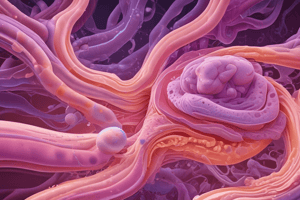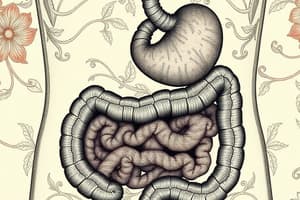Podcast
Questions and Answers
What primarily determines the contraction rhythm of smooth muscle in the gastrointestinal tract?
What primarily determines the contraction rhythm of smooth muscle in the gastrointestinal tract?
- Intracellular free calcium levels
- Frequency of action potentials
- Na+ influx in response to stimuli
- Frequency of slow waves (correct)
In the absence of muscle contraction after drug X is applied, which step in the contraction-relaxation process is likely inhibited?
In the absence of muscle contraction after drug X is applied, which step in the contraction-relaxation process is likely inhibited?
- Activation of myosin light chain kinase
- Opening of membrane calcium channels (correct)
- Opening of sarcoplasmic reticulum calcium channels
- Binding of ACh with membrane receptors
What is the role of the myenteric plexus in the gastrointestinal tract?
What is the role of the myenteric plexus in the gastrointestinal tract?
- Regulates blood flow
- Stimulates gut mucosa
- Controls gastrointestinal secretion
- Controls GIT movements (correct)
Which part of the sympathetic nervous system primarily inhibits gastrointestinal activity?
Which part of the sympathetic nervous system primarily inhibits gastrointestinal activity?
What neurotransmitter is released to cause contraction of an intestinal muscle cell in response to intrinsic nerve stimulation?
What neurotransmitter is released to cause contraction of an intestinal muscle cell in response to intrinsic nerve stimulation?
What is the primary function of the submucosal plexus?
What is the primary function of the submucosal plexus?
Which statement accurately describes the effects of norepinephrine on the gastrointestinal tract?
Which statement accurately describes the effects of norepinephrine on the gastrointestinal tract?
Which of the following statements about slow waves is true?
Which of the following statements about slow waves is true?
What is the primary function of the gastrocolic reflex?
What is the primary function of the gastrocolic reflex?
Which hormone is responsible for stimulating gastric acid secretion?
Which hormone is responsible for stimulating gastric acid secretion?
What triggers the release of cholecystokinin (CCK)?
What triggers the release of cholecystokinin (CCK)?
What is the role of the vagovagal reflex?
What is the role of the vagovagal reflex?
What condition does the enterogastric reflex primarily address?
What condition does the enterogastric reflex primarily address?
Which structure primarily integrates the signals for the defecation reflex?
Which structure primarily integrates the signals for the defecation reflex?
What role does gastrin play in the gastrointestinal system?
What role does gastrin play in the gastrointestinal system?
What effect does cholecystokinin (CCK) have on the gallbladder?
What effect does cholecystokinin (CCK) have on the gallbladder?
What is the primary function of the longitudinal muscle layer in the gastrointestinal tract?
What is the primary function of the longitudinal muscle layer in the gastrointestinal tract?
Which type of electrical activity in the gastrointestinal smooth muscle is characterized by a gradual rise and fall in membrane potential?
Which type of electrical activity in the gastrointestinal smooth muscle is characterized by a gradual rise and fall in membrane potential?
Which component of the gastrointestinal tract acts as electrical pacemakers for smooth muscle cells?
Which component of the gastrointestinal tract acts as electrical pacemakers for smooth muscle cells?
What are spike potentials triggered by in the gastrointestinal tract smooth muscle?
What are spike potentials triggered by in the gastrointestinal tract smooth muscle?
What is the main role of gap junctions in gastrointestinal smooth muscle?
What is the main role of gap junctions in gastrointestinal smooth muscle?
What is the significance of the interstitial cells of Cajal's ion channels during slow wave generation?
What is the significance of the interstitial cells of Cajal's ion channels during slow wave generation?
What part of the gastrointestinal system secretes a viscous fluid?
What part of the gastrointestinal system secretes a viscous fluid?
Which of the following best describes the state of gastric smooth muscle contraction?
Which of the following best describes the state of gastric smooth muscle contraction?
What is the primary role of Cholecystokinin (CCK)?
What is the primary role of Cholecystokinin (CCK)?
Which condition stimulates the secretion of Secretin?
Which condition stimulates the secretion of Secretin?
What effect does Gastric Inhibitory Peptide (GIP) have on gastric acid secretion?
What effect does Gastric Inhibitory Peptide (GIP) have on gastric acid secretion?
Which hormone is primarily responsible for increasing gastrointestinal motility during fasting?
Which hormone is primarily responsible for increasing gastrointestinal motility during fasting?
What is the mechanism of action of peristalsis in the gastrointestinal tract?
What is the mechanism of action of peristalsis in the gastrointestinal tract?
What is the primary site of secretion for Gastric Inhibitory Peptide (GIP)?
What is the primary site of secretion for Gastric Inhibitory Peptide (GIP)?
Which hormone would most likely be injected to initiate intense contractions of the proximal duodenum?
Which hormone would most likely be injected to initiate intense contractions of the proximal duodenum?
What type of digestive movement is characterized by moving food forward along the digestive tract?
What type of digestive movement is characterized by moving food forward along the digestive tract?
What is primarily responsible for the movement of contents towards the anus in the gastrointestinal tract?
What is primarily responsible for the movement of contents towards the anus in the gastrointestinal tract?
Which substances are released from the intestinal mucosa to increase blood flow during gastrointestinal activity?
Which substances are released from the intestinal mucosa to increase blood flow during gastrointestinal activity?
Which of the following correctly indicates a potential cause of chronic diarrhea?
Which of the following correctly indicates a potential cause of chronic diarrhea?
What impact does atropine have on the gastrointestinal system?
What impact does atropine have on the gastrointestinal system?
What is the primary function of reticuloendothelial cells in the liver?
What is the primary function of reticuloendothelial cells in the liver?
Which disorder is specifically characterized by reverse peristalsis?
Which disorder is specifically characterized by reverse peristalsis?
What condition can result from chronic diarrhea due to loss of bicarbonate?
What condition can result from chronic diarrhea due to loss of bicarbonate?
How do segmentation contractions contribute to digestion?
How do segmentation contractions contribute to digestion?
Study Notes
Gastrointestinal Smooth Muscle Contraction
- Pacemaker activity of interstitial cells of Cajal is the primary determinant of smooth muscle contraction rhythm in the gastrointestinal tract.
- Drug X inhibiting muscle contraction likely disrupts the calcium release step in the contraction-relaxation process.
- Myenteric plexus controls motility within the gastrointestinal tract.
- Sympathetic nervous system's postganglionic fibers inhibit gastrointestinal activity.
- Acetylcholine is the neurotransmitter responsible for intestinal muscle cell contraction in response to intrinsic nerve stimulation.
Gastrointestinal Regulation
- Submucosal plexus regulates gastrointestinal secretions.
- Norepinephrine inhibits gastrointestinal motility.
- Slow waves are slow, rhythmic fluctuations in membrane potential of gastrointestinal smooth muscle and do not cause muscle contraction.
- Gastrocolic reflex triggers mass movement in the colon following a meal in the stomach.
- Gastrin stimulates gastric acid secretion.
Gastrointestinal Hormones and Reflexes
- Cholecystokinin (CCK) release is triggered by presence of fatty acids and amino acids in the duodenum.
- Vagovagal reflex involves sensory and motor fibers of the vagus nerve, regulates gastric motility and secretion.
- Enterogastric reflex primarily addresses the inhibition of gastric emptying when the duodenum is full.
- Defecation reflex integration occurs primarily in the spinal cord.
- Gastrin promotes gastric motility and secretion.
- Cholecystokinin (CCK) stimulates gallbladder contraction and release of bile.
Gastrointestinal Structure and Function
- Longitudinal muscle layer is primarily responsible for shortening and propelling intestinal contents.
- Slow waves are characterized by a gradual rise and fall in membrane potential of gastrointestinal smooth muscle.
- Interstitial cells of Cajal act as electrical pacemakers for smooth muscle cells in the gastrointestinal tract.
- Spike potentials are triggered by depolarization of the membrane beyond a threshold in the smooth muscle of the gastrointestinal tract.
Gastrointestinal Cell Communication and Function
- Gap junctions in gastrointestinal smooth muscle facilitate communication and synchronous contraction of muscle cells.
- Interstitial cells of Cajal's ion channels play a key role in slow wave generation.
- Stomach secretes mucus , which provides protection and lubrication.
- Gastric smooth muscle generally exists in a tonic state of contraction.
- Cholecystokinin (CCK) primarily regulates gallbladder emptying and pancreatic enzyme secretion.
- Secretin is stimulated by presence of acidic chyme in the duodenum.
- Gastric Inhibitory Peptide (GIP) inhibits gastric acid secretion.
- Motilin increases gastrointestinal motility during fasting.
- Peristalsis uses coordinated contractions and relaxations of the gastrointestinal smooth muscle to move food forward.
- Duodenum is the primary site of secretion for Gastric Inhibitory Peptide (GIP).
- Cholecystokinin (CCK) could be injected to initiate intense contractions in the proximal duodenum.
- Peristalsis is a type of digestive movement that propels food forward.
- Intestinal smooth muscle contractions are responsible for the movement of contents towards the anus in the gastrointestinal tract.
- Intestinal mucosa releases vasodilators to increase blood flow during gastrointestinal activity.
- Chronic diarrhea could potentially be caused by malabsorption, infection or bowel disorders.
- Atropine inhibits acetylcholine's effect, decreasing gastrointestinal motility.
- Reticuloendothelial cells in the liver are involved in phagocytosis and immune response.
- Reverse peristalsis is characteristic of vomiting as it moves stomach contents upward.
- Chronic diarrhea can lead to metabolic alkalosis due to loss of bicarbonate.
- Segmentation contractions mix chyme with digestive juices for efficient digestion.
Studying That Suits You
Use AI to generate personalized quizzes and flashcards to suit your learning preferences.
Related Documents
Description
Explore the structure and functions of the gastrointestinal system in this quiz. Learn about the GIT wall layers, smooth muscle functions, and electrical activity in digestion. Test your knowledge on how these components work together for nutrient absorption.




